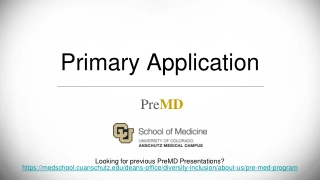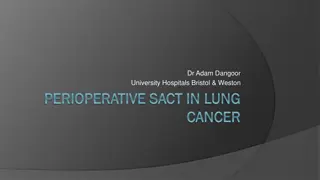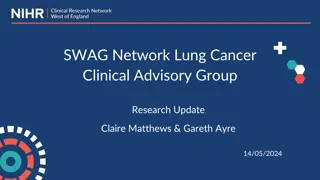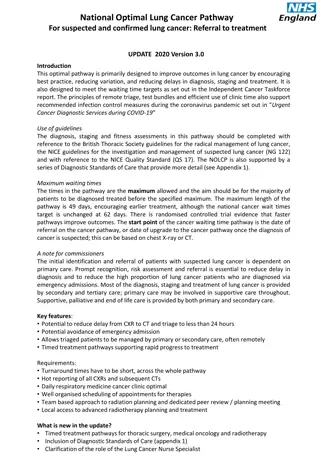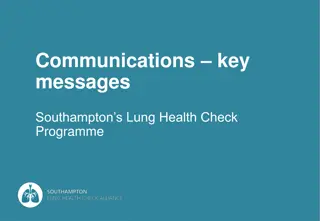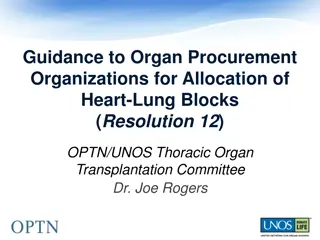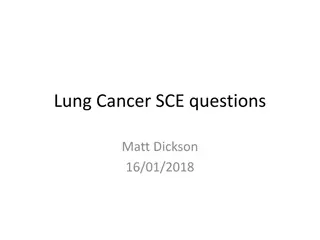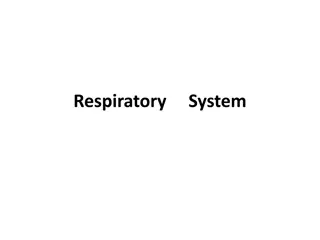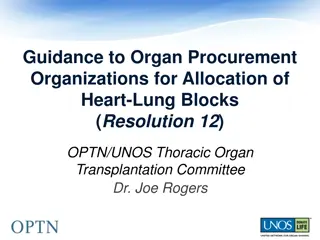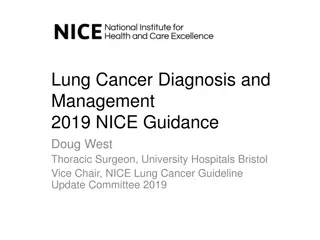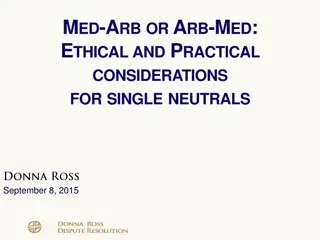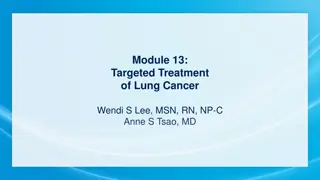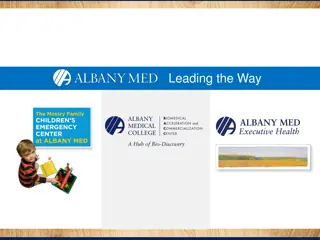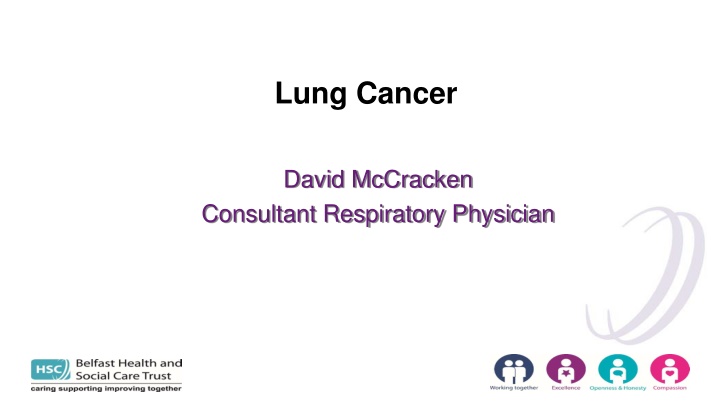
Lung Cancer: Causes, Symptoms, and Treatments
Explore the epidemiology, causes, symptoms, staging, prognosis, and treatments of lung cancer. Discover the impact of smoking, workplace exposures, and other factors on lung cancer risk. Learn about survival rates and the importance of early detection in improving outcomes.
Download Presentation

Please find below an Image/Link to download the presentation.
The content on the website is provided AS IS for your information and personal use only. It may not be sold, licensed, or shared on other websites without obtaining consent from the author. If you encounter any issues during the download, it is possible that the publisher has removed the file from their server.
You are allowed to download the files provided on this website for personal or commercial use, subject to the condition that they are used lawfully. All files are the property of their respective owners.
The content on the website is provided AS IS for your information and personal use only. It may not be sold, licensed, or shared on other websites without obtaining consent from the author.
E N D
Presentation Transcript
Lung Cancer David McCracken Consultant Respiratory Physician
Outline Epidemiology and demographics Causes Symptoms (including specific syndromes) Classification Investigations Staging Prognosis Treatments
Epidemiology There are around 47,800 new lung cancer cases in the UK every year Lung cancer is the 3rd most common cancer in the UK, accounting for 13% of all new cancer cases Around three-quarters of lung cancer cases are diagnosed at a late stage There are around 35,300 lung cancer deaths in the UK every year Lung cancer is the most common cause of cancer death in the UK, accounting for 21% of all cancer deaths
Epidemiology One year survival is 40.6% Five year survival is 16.2% Ten year survival is 9.5% Lung cancer survival in the UK has not shown much improvement in the last 40 years When diagnosed at its earliest stage, 88% people with lung cancer will survive their disease for one year or more and 57% will survive for five years or more, compared with 19% one year survival and 3% five year survival when the disease is diagnosed at the latest stage
Causes In the UK: 72% of lung cancer cases are caused by smoking 5% of cases are caused by ionising radiation 13% of cases are caused by workplace exposures 8% of cases are caused by air pollution Some quote as high as 90% of cases caused by smoking Risk increased by asbestos exposure, pulmonary fibrosis and HIV amongst others 79% lung cancer cases deemed preventable
Causes: smoking Lung cancer risk increases with both smoking duration and amount Lung cancer risk in people who smoke is higher in those who start smoking at a younger age Lung cancer risk is much lower in people who used to smoke compared with people who currently smoke, and the gap widens as time since quitting smoking increases Lung cancer risk in people who used to smoke who quit around 7 years previously is 43% lower compared with current smokers Lung cancer risk in ex-smokers who quit around 12 years previously is 72% lower compared with people who currently smoke
Symptoms Symptoms often not present until a late stage Cough (50-75%) Haemoptysis (20-50%) Chest pain (20-40%) Pleural invasion, PE Dyspnoea (25-45%) airway obstruction, obstructive pneumonitis, lymphangitis, pneumothorax, pleural effusion, pericardial effusion Weight loss
Symptoms The most common sites of metastases are the liver, adrenal glands, bones and brain Bone Pain, hypercalcaemia Brain headache, vomiting, visual field loss, hemiparesis, cranial nerve deficit and seizures
Specific Presentations Superior vena cava obstruction (SVCO) Large central mass, often on the right CXR often shows widening of the mediastinum or right hilar mass Symptoms: feeling of fullness in the head Signs: plethoric face, distended veins on neck and chest, dyspnoea
Specific Presentations Pancoast Tumour Tumour that occurs in the superior sulcus Shoulder pain, atrophy of small muscles of the hand, Horner s syndrome
Specific Presentations Paraneoplastic phenomena Hypercalcaemia Bony metastases Tumour secretion of a parathyroid hormone-related protein (PTHrP) Hyponatraemia SIADH Cushing s Syndrome Ectopic ACTH production Neurologic syndromes Lambert-Eaton
Classification Non-small cell lung cancer (NSCLC) Accounts for around 80% Includes: Squamous cell carcinoma Adenocarcinoma Lepidic adenocarcinoma (previous bronchoalveolar) Small cell lung cancer Around 15% Most aggressive type Usually metastasised at time of presentation
Investigations Chest x-ray may be normal and so not a good screening test CT Chest should include upper abdomen PETCT assess for distant metastases if radical/curative treatment being considered Spirometry Bronchoscopy CT guided biopsy US guided lymph node biopsy Pleural aspiration
Investigations Assessment of fitness ECOG performance status
Staging: SCLC Limited disease Tumour confined to the ipsilateral hemithorax Extensive disease Tumour beyond the boundaries of limited disease including malignant pericardial or pleural effusions
Staging: TNM T1 Tumour <3cm T2 Tumour 3-5cm or involves visceral pleura or main bronchus T3 Tumour 5-7cm or invading chest wall, pericardium, phrenic nerve or separate nodule(s) in the same lobe T4 Tumour >7cm or invading mediastinum, diaphragm, heart, great vessels, recurrent laryngeal nerve, carina, trachea, oesophagus, spine or nodule(s) in a different ipsilateral lobe
Staging: TNM N0 - No regional node metastasis N1 - Metastasis in ipsilateral pulmonary or hilar nodes N2 - Metastasis in ipsilateral mediastinal or subcarinal nodes N3 - Metastasis in contralateral mediastinal, hilar, or supraclavicular nodes M0 - No distant metastasis M1a - Malignant pleural or pericardial effusion or separate tumour nodule(s) in a contralateral lobe M1b - Single extrathoracic metastasis M1c - Multiple extrathoracic metastases (1 or>1 organ)
Prognosis Small Cell Limited: with treatment - 12 months without treatment 12 weeks with treatment 8 months without treatment 6 weeks Extensive:
Treatment: small cell Limited stage: Surgery rarely an option but may be considered in very early stages (T1-2a N0 M0) Treated with combined chemoradiotherapy if fit, chemotherapy if not (cisplatin based) Can consider sequential treatment if borderline Prophylactic cranial radiotherapy if no progression on treatment Extensive stage: Combination chemotherapy (platinum based) Thoracic radiotherapy if partial or complete response in the chest Prophylactic cranial radiotherapy if good response to treatment
Treatment: NSCLC Radical/Curative options Surgery Often for small, localised tumours with little or no lymph node involvement Offers best chance of cure Radiotherapy (SABR/SBRT) As above but if not suitable for surgery (not fit or patient choice) Better tolerated Slightly lower chance of cure
Treatment: NSCLC Radiofrequency ablation (RFA) Can be considered for small lesions if not suitable for other treatments Chemoradiotherapy Used for locally advanced malignancy (Often stage III/for non-resectable tumours)
Treatment: NSCLC Non-radical/Palliative SACT/Combination chemotherapy Metastatic/disseminated malignancy
Treatment: NSCLC Some lung cancers exhibit markers of mutations in specific molecular pathways or genetic alterations This has lead to the development of targeted or personalised treatments Includes tyrosine kinase inhibitors (TKIs) for EGFR & ALK mutations or immune checkpoint inhibitors (immunotherapy) for PDL1 expression Improved survival and often better tolerated
Screening? Screening has been considered an option to address lung cancer mortality Aim is to identify cancers earlier when there is a higher likelihood of curative treatment NLCST & NELSON both showed significant reductions in mortality But significant anxiety for patients Patients undergoing tests/surgery that may not have been necessary increased demand on radiology & surgery Not cost effective at present
Summary Smoking is the primary cause Smoking cessation at any time is beneficial even after the diagnosis of lung cancer Lung cancer often presents late and as a result has a very poor mortality It can present in many different ways, including with paraneoplastic phenomena Most are non-small cell, but small cell is more aggressive and will almost always metastasise early Treatment options vary but are based on stage, fitness and patient choice

